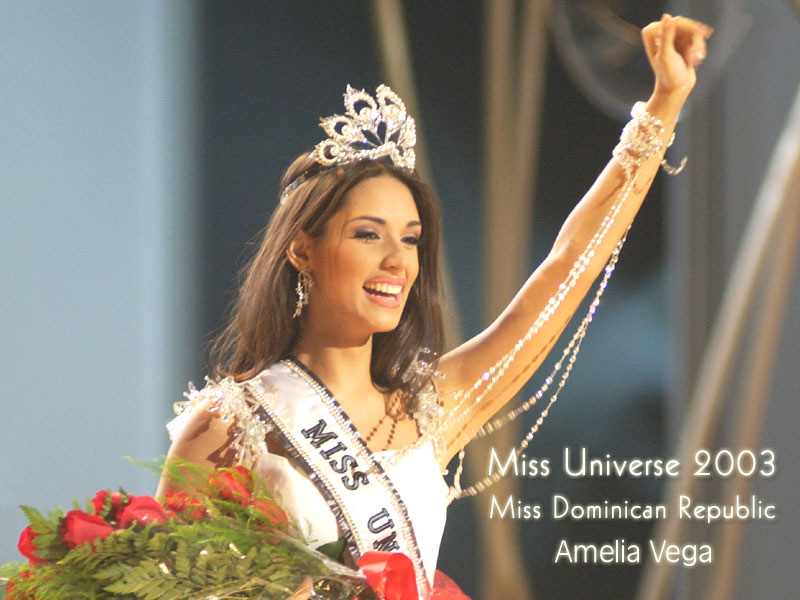
This is Miss Universe 2003 a.k.a. Miss Dominican Republic. In a country where
73% identify as mixed and 11% as black we have historically sent very light skinned Anglo-Dominicans to the Miss Universe pageants. I highlight Miss Universe in order to narrow the focus of my post. I will be focusing on the Dominican gaze as it pertains to Dominican women.
Back to the male gaze. John Berger identifies the structures in place that account for the engendering of "seeing." The gaze is distinctly male, that is, one that appeals to the male audience or the male conventions. Consequently, the ways women see is distinctly colored by the influence of the male gaze. Women don't see things, they see themselves being seen (to paraphrase).
He uses example in Art History, pornography and advertisements to illustrate the pervasiveness of this gaze. There is an example of a female nude renaissance painting juxtaposed with a woman in a porn magazine. The context of the pictures are radically different but the form of the woman is the same
The male gaze casts a pervasive and incessant influence on all manners of media and art. So much so that is has engendered the way we as human beings interact. The role of that gaze is not with out its realistic counterparts. Women go to great lengths to "look" a certain way. But what is this looking without its audience? Berger would suggest that this audience is distinctly male.
Conversely, Bell Hooks argument for the oppositional gaze is an indirect antidote to to Berger's claim. Hooks writes in the 90s, more than 20 years after Berger writes Ways of Seeing. Her work on the oppositional gaze builds on top of decades of feminist writing on the male gaze. Hooks identifies an alternative way of seeing that is not only gendered but racial. The predominant way of seeing is not only male but white. Hooks would argue that the gaze is FIRST white and then male, because of the saturation of white superiority in culture. The oppositional gaze is a response and adaptation to the way non-whites, particularly black women, consume media.
Hooks speaks of her experience as a young girl watching Amos and Andy (racist TV show from the 50s)and how it shaped the way she view the world. The show didn't completely shape her perception of blacks in the U.S. but rather is showed the way white culture saw blacks. It perpetuated that way of seeing by being "entertainment" and therefore completely innocent to charges of racism.
Back to Miss Universe. As a Dominican-American the gaze that I have always encountered is one grounded in the colonial history of the Dominican Republic. Despite the statistics that contradict the images of Dominican people we as Americans are exposed, 90% of Dominicans have some West African ancestry. Dominicans, in some fascinating feat of black-denial, claim any trace of dark skin to some cooked up long lost Indian ancestry--despite the fact that the natives of the Hispanola were decimated in the 16th century.
My experience as a light-skinned, afro-haired Dominican has always been in direct opposition to a lot of my Dominican paisanos. My hair is a topic of political discourse because it hasn't been chemically altered to be straight. My lips are an "embarrasing" African ancestry appendage. And my light skin is the "compensation" to the affliction imposed on me. Translation: Zoila you got bad hair and damn you half black? But at least you light skinned."
People have actually said this to me, in the 21st century.
The way Dominican people see (pardon the gross generalization) is an example of the careful and deliberate denial of anything African. Our models, celebrities and representatives are careful to note their lilting Spanish, our deliberately non-African hair and light skin. The question remains is this the way we want to be seen or what others want to see of us?
Despite the fact that Dominicans and Dominican-Americans are an increasing presence in sports, entertainment and media there is a difficult renegotiation who and what we are. This process of how we are seen and how we see is new and treacherous because our numbers are increasing in the states. Nevertheless, we must take notice of the simplicity of the ways of seeing as it pertains to Dominicans.
Berger's essay argued for the idea that looking is not an objective empirical enterprise, rather it is one that is cultivated and shaped to fit a certain male taste. Furthermore, Bell Hooks essay argued that looking is not only cultivated and shaped to fit a certain male taste but a polemic. They identified looking as more than a mere verb but a powerful cultural exchange in what we see, how we see it and why we see it.
I choose the example of Miss Universe 2003 to highlight a concern of mine that has come up after reading these essays. If women are to be looked at, and models are seen as symbols of beauty then why do we choose symbols that oppose what most of us look like?

No comments:
Post a Comment